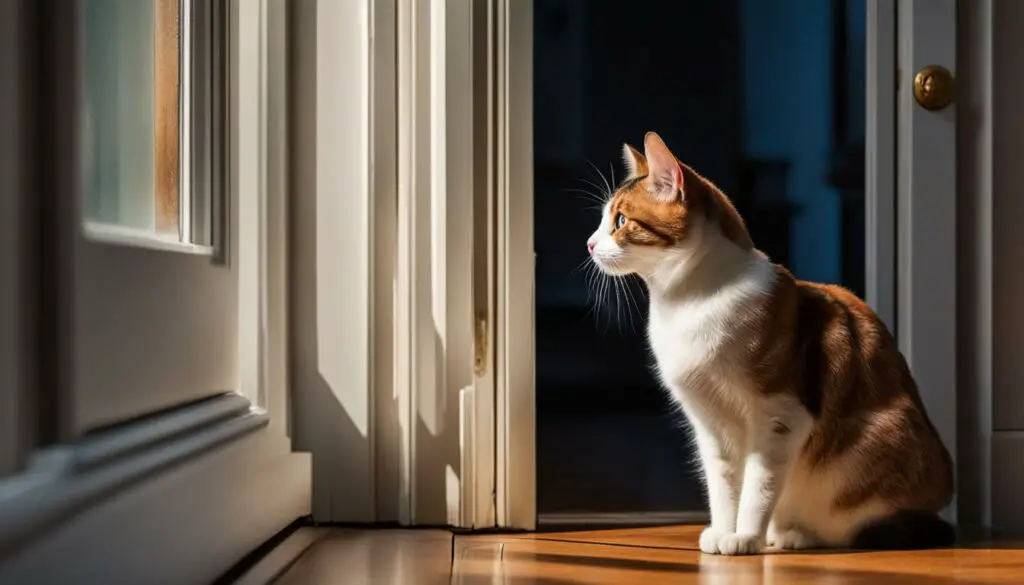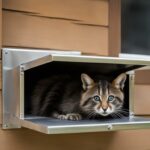As a cat guardian, one of my greatest fears is my beloved feline friend escaping through an open door. That’s why I’ve dedicated myself to finding strategies and tips to keep my cat safe indoors, even when the door is open. In this article, I will share with you what I’ve learned, so you can provide a secure and enriching environment for your indoor cat.
Key Takeaways:
- Keeping your cat safe indoors with the door open is possible with the right precautions.
- Create an enriched environment with toys, scratching posts, and interactive games to prevent boredom.
- Consider your cat’s temperament before leash training, as it may increase their desire to go outside.
- Train your cat to come when called using positive reinforcement for added safety.
- Use distraction techniques and alternate entry systems to prevent door escapes.
The Importance of Creating an Enriched Environment for Your Cat
As a responsible cat owner, it’s essential to understand the importance of creating an enriched environment for your furry friend. Indoor cats, in particular, rely on their human companions to provide them with a stimulating and fulfilling environment that prevents boredom and encourages their natural behaviors.
By incorporating various elements into your cat’s surroundings, you can create a space that keeps them happy and entertained. Start by providing plenty of toys that offer mental and physical stimulation. Interactive toys, such as puzzle feeders or treat-dispensing balls, can keep your cat engaged and prevent them from becoming bored.
Additionally, consider investing in cat perches or cat trees to give your feline companion a sense of height and security. Cats are natural climbers, and these structures allow them to exercise their natural instincts. Additionally, a scratching post is crucial for your cat’s mental and physical well-being, as it provides an outlet for their natural urge to scratch and helps keep their claws healthy.
| Enrichment Elements | Description |
|---|---|
| Toys | Provide a variety of toys that engage your cat’s hunting instincts, such as wand toys or feather teasers. |
| Scratching Posts | Choose sturdy scratching posts covered in sisal or other cat-friendly materials to satisfy your cat’s need to scratch. |
| Perches or Cat Trees | Giving your cat a high vantage point can fulfill their desire to observe their surroundings from a safe spot. |
| Hideouts or Cat Caves | Having cozy hideouts or cat caves provides your cat with a private and secure space. |
“Creating an enriched environment for your cat is about more than just providing physical items. It’s also about engaging with your cat through play and spending quality time together. Cats thrive on human interaction, so make sure to set aside dedicated playtime every day.”
Remember, an enriched environment not only prevents boredom but also helps alleviate stress and anxiety in indoor cats. By understanding your cat’s natural instincts and providing them with the necessary tools for mental and physical stimulation, you can create a space where they can truly thrive.
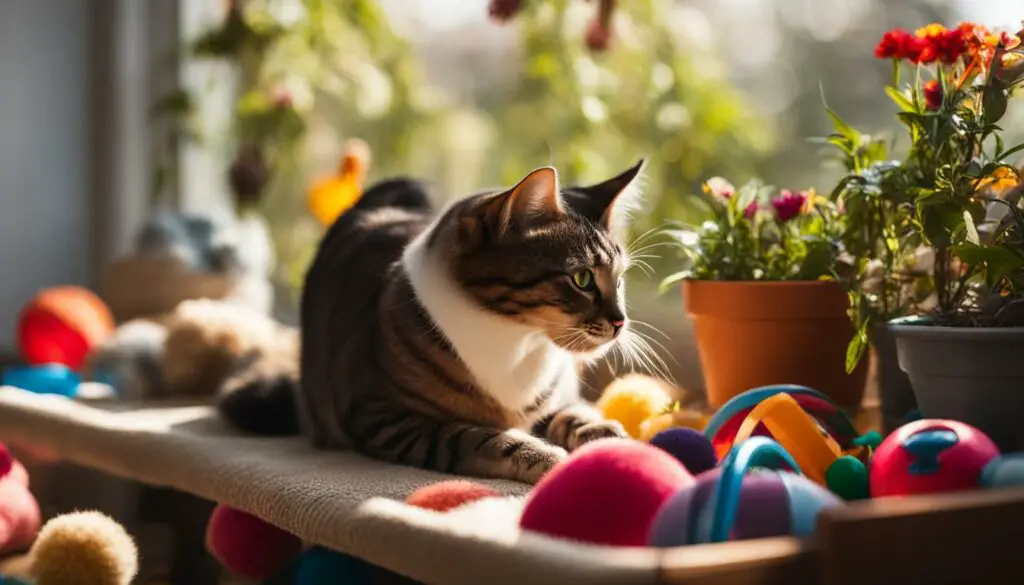
The Potential Dangers of Leash Training for Indoor Cats
Leash training has gained popularity as a way to safely introduce indoor cats to the great outdoors. While it may seem like a promising solution, it’s essential to consider your cat’s temperament before embarking on this training journey. Not all cats are suited for leash training, and for some, it may actually increase their desire to escape.
Cat temperament plays a significant role in determining whether leash training is suitable. Some cats have a strong prey drive and may become overly stimulated by the sights, sounds, and scents outdoors. This enticement can lead to frustration and a greater longing to be outside, potentially resulting in more attempts to escape. It’s important to assess your cat’s personality and consider whether leash training would be a positive experience for them.
Additionally, leash training requires careful supervision and control. Outdoor enticements, such as birds or other animals, can easily distract a cat and lead to sudden pulls on the leash, potentially causing injury. It’s crucial to remain vigilant during walks and be prepared to react quickly if your cat becomes startled or agitated. Always use a properly fitted harness rather than a collar to minimize the risk of injury.
Table: Pros and Cons of Leash Training for Indoor Cats
| Pros | Cons |
|---|---|
| Allows cats to experience the outdoors in a controlled environment | Can increase a cat’s desire to escape |
| Provides mental and physical stimulation | Requires careful supervision and control |
| Can be a bonding activity between cat and owner | May not be suitable for all cat temperaments |
If you decide to pursue leash training for your indoor cat, take it slow and start in a calm, familiar environment. Gradually introduce the harness and leash, allowing your cat to adjust at their own pace. Reward positive behavior and provide plenty of praise and treats. However, always prioritize the safety and well-being of your cat and be prepared to reassess if leash training is causing undue stress or anxiety.
Remember, not all cats need or enjoy outdoor excursions. Providing a stimulating and enriched indoor environment, complete with toys, scratching posts, and interactive playtime, can fulfill their need for exploration and keep them content and safe within the comforts of your home.
Training Your Cat to Come When Called
Training your cat to come when called is an essential skill that can keep them safe in various situations. Whether they accidentally escape outdoors or you need to reach them quickly in an emergency, having a reliable recall signal can make all the difference. Here are some tips and techniques to help you train your cat to come when called.
Creating a Positive Association:
Start by associating a specific sound or word with something positive, such as a treat or their favorite toy. Use this signal consistently and reward them every time they respond to it. Over time, they will learn to associate the sound or word with a positive experience and be more likely to come when called.
Repetition and Practice:
Consistency and repetition are key when training your cat. Start by practicing in a quiet and familiar environment, gradually increasing the level of distractions as they become more responsive. Use the recall signal during playtime or feeding to reinforce the association and encourage them to come to you.
| Training Tips | Benefits |
|---|---|
| Use high-value rewards, such as their favorite treats or toys, to motivate them. | Increased motivation and positive reinforcement. |
| Keep training sessions short and frequent to maintain their interest and focus. | Improved concentration and retention of the recall signal. |
| Practice in different locations to generalize the behavior and ensure they respond in various settings. | Transferability of the recall signal to different environments. |
Remember, every cat is unique, and their response to training may vary. Patience, consistency, and positive reinforcement are essential for successful recall training.
Building Trust:
It’s important to create a trusting and positive relationship with your cat during training. Avoid punishment or negative reinforcement, as this can undermine their trust and hinder their progress. Instead, focus on rewarding their desired behavior and reinforcing the bond between you.
Caution When Opening Doors
If you have a cat that tends to dart for the door when it’s being opened, it’s important to take precautions to prevent their escape. Door darters can be quick and sneaky, and it only takes a split second for them to slip out and potentially put themselves in danger. Here are some strategies to distract your cat from the door and keep them safe inside:
1. Use Distraction Techniques:
When you know you’re going to open a door, have some treats or a favorite toy ready to redirect your cat’s attention. As soon as you start opening the door, toss the treats or play with the toy to create a distraction. This can help keep their focus away from the door and prevent them from attempting to escape.
2. Avoid Using Squirt Bottles:
While squirting your cat with water may seem like a quick solution to discourage door darting, it can actually make the situation worse. Cats may associate the negative experience with the person opening the door, causing them to become fearful or anxious around that individual. Instead, opt for positive reinforcement and distraction techniques to redirect their attention.
3. Consider Using a Laser Pointer:
One effective way to distract your cat from the door is to use a laser pointer. Cats are naturally drawn to chasing and pouncing on moving lights, so using a laser pointer can be a fun and engaging way to redirect their attention away from the door. Just make sure to never shine the laser directly into your cat’s eyes.
By following these cautions and distractions, you can help prevent your cat from escaping when doors are opened. Remember, the safety of your cat is paramount, and a little extra vigilance can go a long way in keeping them protected indoors.
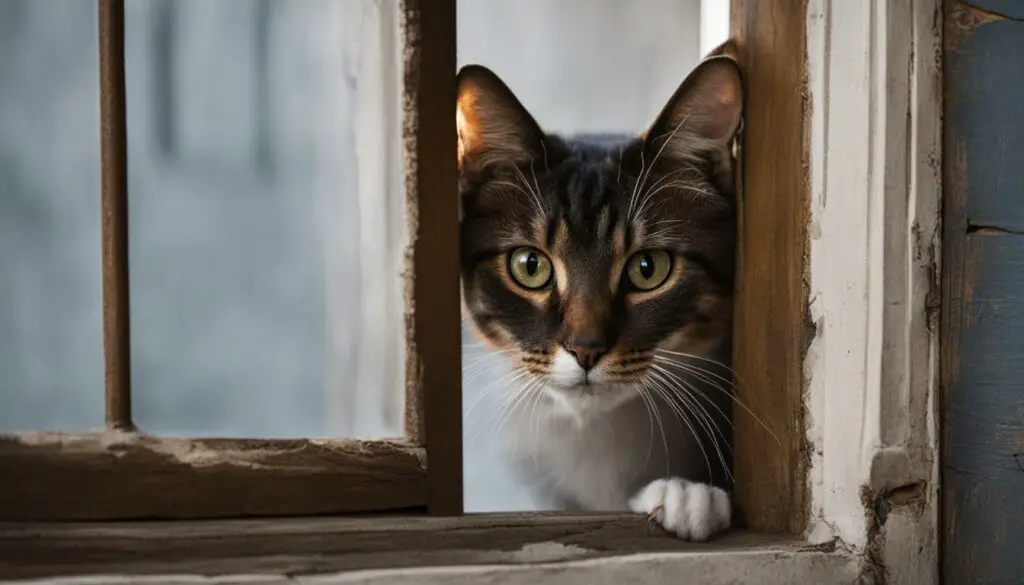
Alternate Entry Systems for Enhanced Safety
When it comes to keeping our cats safe indoors, preventing escape is a top priority. One effective strategy to enhance their safety is by implementing alternate entry systems. By utilizing a double entry system, such as entering through the garage or a different doorway, we can ensure that our cats cannot escape when visitors enter or when we have our hands full.
One option is to create a safe entry point through the garage. This can be achieved by installing a cat door that leads directly into the garage from the house. By using this designated entrance, we can minimize the risk of our cats slipping out through the front door when it’s opened. It also provides a secure and controlled environment for them to enter and exit.
Another alternative is to establish a separate entrance, such as a dedicated door or gate that leads to a confined area. This can be especially useful if you have a porch or enclosed patio that allows your cat to enjoy a bit of fresh air without the risk of full outdoor access. By restricting their entry and exit to this designated space, you can provide a safe environment for them to explore while keeping them away from potential dangers.
Implementing these alternate entry systems not only helps prevent escape but also adds an extra layer of security for our beloved feline friends. By creating designated entry points and confining their access to certain areas, we can ensure that our cats remain safely inside our homes while still enjoying a taste of the outdoors.
Table: Comparison of Alternate Entry Systems
| Entry System | Advantages | Considerations |
|---|---|---|
| Garage Entrance | – Direct access from house to garage\n- Minimizes risk of escape through front door | – Requires installation of a cat door\n- May limit access to certain areas of the home |
| Separate Door or Gate | – Provides designated entry point\n- Allows restricted access to outdoor space | – Requires separate construction or installation\n- May require training to use designated entry points |
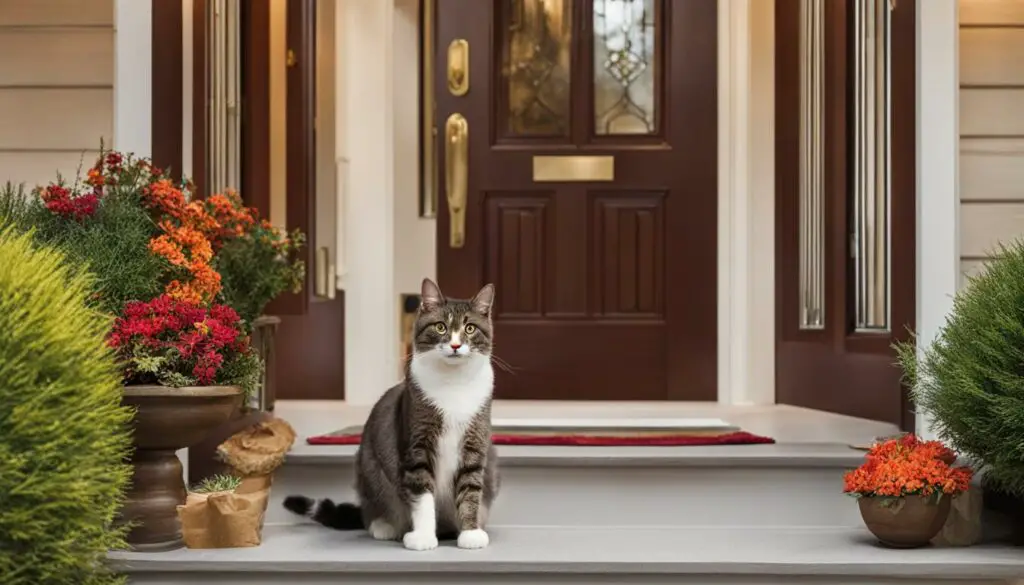
The Importance of Restricting Access During Service or Repair
When you have service or repair persons in your home, it’s crucial to keep your cat confined to a separate room to prevent any accidental escapes. Cats are naturally curious creatures, and the presence of unfamiliar people and equipment may cause them to become anxious or try to explore restricted areas. By restricting your cat’s access to the confined area, you can ensure their safety and provide a stress-free environment for both your feline friend and the service or repair persons.
To keep your cat away from the active service or repair area, designate a specific room or space where they can stay comfortably. Prepare the room by providing their litter box, food, water, toys, and a cozy bed. This will help them feel secure and entertained while the work is being done. Additionally, make sure the room is escape-proof by checking for any small openings or gaps where your cat could squeeze through.
It’s also essential to communicate with the service or repair persons about the presence of your cat. Inform them about any specific instructions or precautions, such as not leaving doors open and being mindful of your cat’s location. This will help create awareness and ensure that the necessary steps are taken to prevent any accidental encounters or escapes. Remember, the safety and well-being of your cat should always be a top priority during service or repair work.
| Service or Repair Precautions | Cat Safety Measures |
|---|---|
| Inform service or repair persons about the presence of your cat | Designate a separate room for your cat |
| Provide specific instructions to service or repair persons | Ensure the designated room is escape-proof |
| Request to keep doors closed and secure | Provide essential supplies and comforts for your cat |
| Ask service or repair persons to be mindful of your cat’s location | Communicate with the service or repair persons |
By following these precautions and taking the necessary measures to restrict your cat’s access during service or repair work, you can ensure that they are kept safe and minimize the risk of escape or injury. Remember to be proactive and communicate effectively with the service or repair persons to create a harmonious and secure environment for everyone involved.
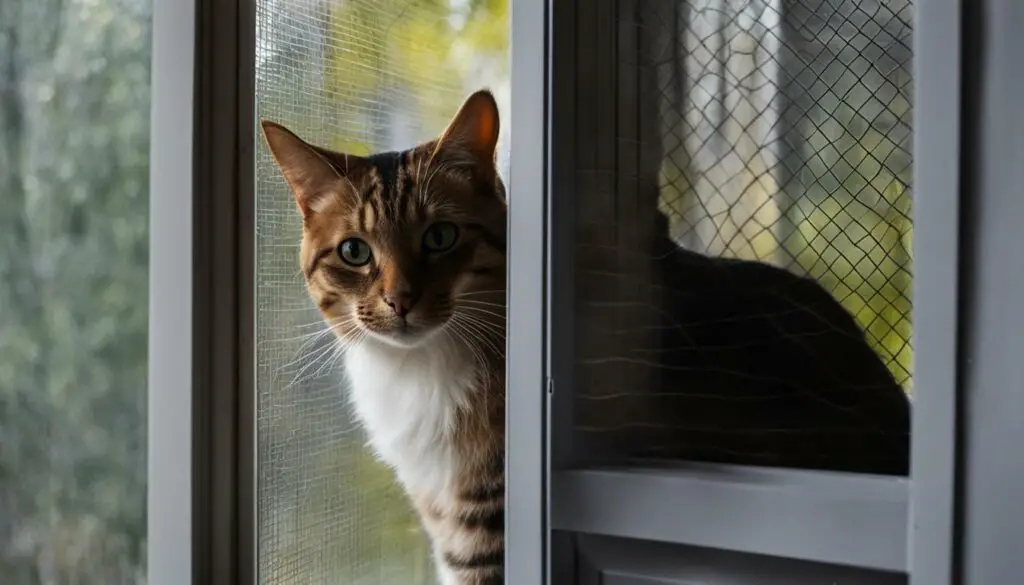
Tips for Confined Area Management:
- Ensure the room is comfortable and includes familiar items from your cat’s usual environment.
- Close windows, blinds, and curtains to prevent your cat from being enticed by stimuli outside.
- Play soft music or use white noise to create a calming atmosphere for your cat.
- Check the room for any potential hazards or toxic substances that your cat could encounter.
- Provide a hiding spot or covered crate in case your cat feels the need to retreat and seek privacy.
- Consider using pheromone diffusers or sprays to help reduce your cat’s stress levels during the confinement period.
Microchipping Your Cat for Added Security
When it comes to keeping your beloved feline friend safe, one of the most effective measures you can take is microchipping. This simple and quick procedure involves inserting a tiny microchip under your cat’s skin, typically between the shoulder blades. The microchip contains a unique identification number that can be scanned by a veterinarian or animal shelter if your cat ever becomes lost or escapes.
Unlike collars or tags, which can easily be lost or removed, a microchip is a permanent form of identification. It provides a reliable way for your lost cat to be identified and reunited with you. In fact, studies have shown that cats with microchips have a significantly higher chance of being returned to their owners compared to those without.
It’s important to note that a microchip is not a tracking device, so you won’t be able to locate your cat’s exact whereabouts if they go missing. However, it does serve as a lifeline of hope, especially when combined with other preventative measures such as keeping your cat indoors and ensuring they have a secure environment.
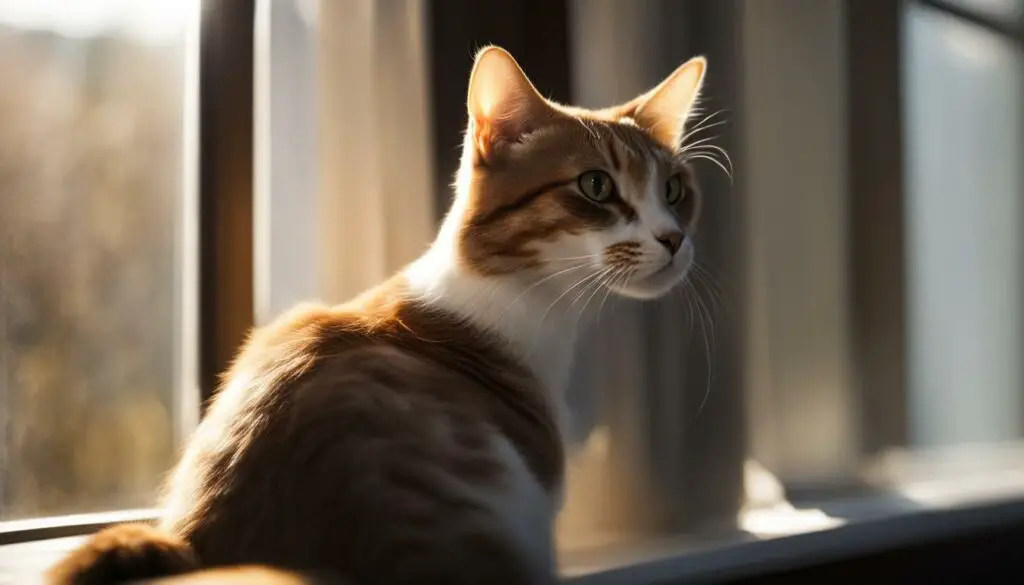
Remember that microchipping is just one part of the puzzle when it comes to keeping your cat safe. It’s also essential to keep their contact information up to date with the microchip registry. This way, if your cat is found, the person who locates them can contact you immediately. Additionally, consider using collar tags with your contact information as an extra layer of identification.
The Benefits of Microchipping Your Cat
Microchipping your cat offers several benefits beyond the simple assurance of identification. Here are a few key advantages:
- Increased chance of being reunited with your lost cat
- Peace of mind that your cat has a secure form of identification
- Protection against potential theft or ownership disputes
- Encouragement for responsible cat ownership
By taking the step to microchip your cat, you are providing an added layer of security that can make all the difference if your furry friend ever goes missing. Remember, accidents happen, and even the most cautious cat guardians can experience a momentary lapse in vigilance. Microchipping is a proactive measure that gives you peace of mind and significantly increases the chances of a happy reunion with your beloved cat.
Transitioning Your Cat to Indoor Life
If you have an outdoor cat that you’d like to transition to an indoor life, it’s important to do so gradually. Rushing the process may cause stress for your cat and make the transition more difficult. Here are some steps you can take to help your cat adjust to their new indoor environment.
Gradual Change
Start by gradually decreasing your cat’s outdoor time. Begin by keeping them indoors for short periods, then gradually increase the duration over time. This helps your cat become more familiar and comfortable with their new indoor surroundings. Provide plenty of engaging toys and interactive play sessions to keep them mentally stimulated while indoors.
Scratching Post and Litter Box
A scratching post is an essential item for indoor cats. It helps them satisfy their natural instinct to scratch while also providing a designated area for them to do so. Place the scratching post near their favorite outdoor scratching spot to encourage them to use it. Additionally, ensure that you have a clean litter box readily available for your cat. Place it in a quiet and accessible area to encourage regular use.
Remember to be patient during this transition period. Each cat is different, and some may take longer to adjust than others. Providing a safe, comfortable, and enriched environment will help your cat feel secure and content indoors.
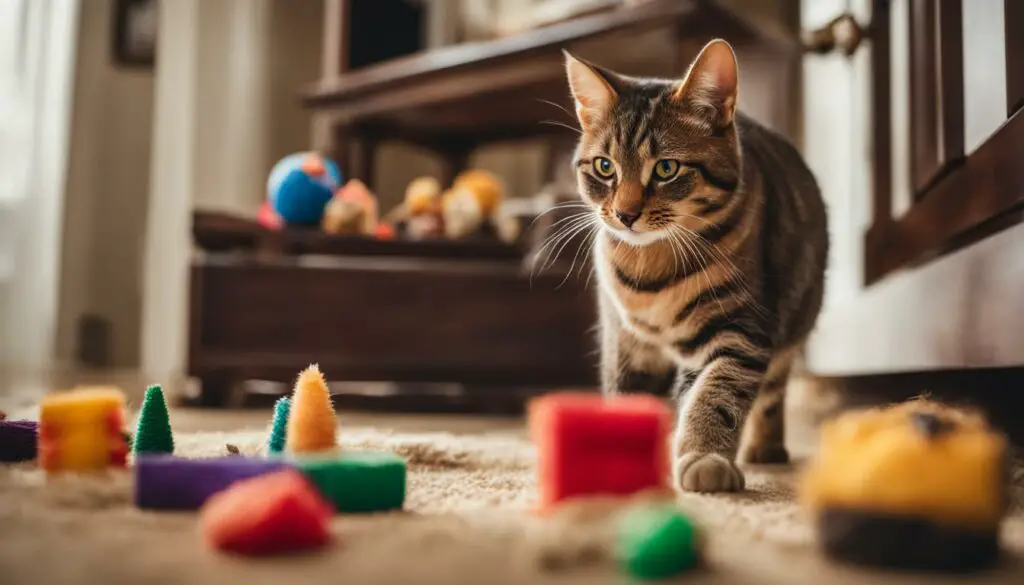
Believe in Your Cat’s Ability to Be Happy Indoors
Many cat owners worry that keeping their cat indoors will make them unhappy. However, it’s important to understand and appreciate your cat’s natural instincts and their ability to adapt to an indoor lifestyle. Cats have a remarkable capacity for happiness and contentment when provided with a safe and enriching environment.
Indoor cats can lead fulfilling lives, free from the dangers and risks associated with the outside world. They have access to a comfortable and controlled environment where they can explore, play, and relax without the threat of traffic accidents, predators, or exposure to diseases.
To ensure your indoor cat remains happy and satisfied, it’s essential to create a stimulating environment that caters to their natural instincts. Provide plenty of toys for mental and physical stimulation, scratching posts to satisfy their need to scratch, and elevated perches where they can observe their surroundings. Incorporating interactive games and puzzle toys can also help keep them mentally engaged and entertained.
Remember, your cat’s happiness indoors also comes from the love and attention you provide. Regular play sessions, affectionate interactions, and providing a consistent routine will contribute to their overall well-being. By believing in your cat’s ability to be happy indoors, you can create a loving and fulfilling environment for them to thrive.
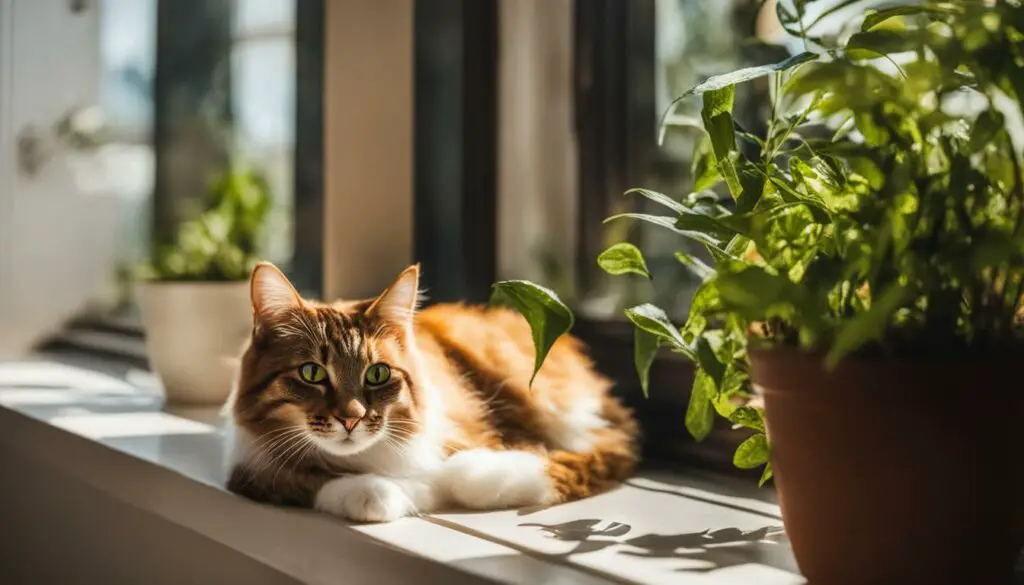
Benefits of an Indoor Lifestyle for Cats
Choosing to keep your cat indoors offers several benefits for both their well-being and your peace of mind:
- Safety: Protects them from hazards like traffic accidents, predators, and exposure to infectious diseases.
- Longevity: Indoor cats generally live longer than outdoor cats due to reduced risk of accidents and illness.
- Health: Minimizes the chances of encountering parasites, getting into fights with other animals, or being exposed to toxic substances.
- Environmental Preservation: Indoor cats do not contribute to the predation of wildlife, helping to protect local ecosystems.
- Bonding: Provides more opportunities for interactions and strengthens the bond between you and your cat.
- Peace of Mind: Eliminates the worry of your cat getting lost or not returning home.
Understanding Your Cat’s Mentality
Cats are highly adaptable creatures with unique personalities. While some cats may initially show signs of restlessness or curiosity about the outside world, they can learn to be content indoors with time and proper environmental enrichment. Understanding your cat’s individual needs and preferences will help you create a fulfilling indoor environment tailored to their specific personality.
It’s important to remember that cats are territorial animals, and your home becomes their territory. By providing them with a safe and enriched indoor space, you are giving them the opportunity to establish their own territory, resulting in a sense of security and contentment.
By embracing your cat’s ability to be happy indoors and creating a stimulating environment that meets their natural instincts, you can provide them with a fulfilling and safe life within the comfort of your home.
Teaching Your Cat Boundaries with Indoor Training
Indoor training is an essential part of keeping your cat safe and happy inside your home. By establishing boundaries and providing appropriate outlets for their natural behaviors, you can ensure that your feline friend remains content and well-adjusted. Here are some tips for teaching your cat boundaries through indoor training:
Using a Scratching Post
Scratching is a natural behavior for cats, and providing them with a designated scratching post is essential. Place the scratching post in an area where your cat frequently goes to scratch, such as near their favorite resting spot. Encourage your cat to use the post by gently guiding their paws towards it and rewarding them with praise or treats when they use it. Be patient and consistent with the training, as it may take time for your cat to develop the preference for the scratching post over furniture or other surfaces.
Introducing the Litter Box
Proper litter box training is crucial for indoor cats. Choose a litter box that is large enough for your cat to comfortably use and place it in a quiet and easily accessible location. Show your cat where the litter box is by gently placing them inside and allowing them to explore. If accidents occur outside the litter box, clean them up without scolding your cat. Consider using a litter attractant or experimenting with different types of litter to find what your cat prefers. Reward your cat with praise or treats when they use the litter box correctly.
Positive Reinforcement
Positive reinforcement is a powerful tool in training your cat. Use treats, praise, and petting to reward your cat for desired behaviors. For example, if your cat uses the scratching post or litter box correctly, provide immediate positive reinforcement. Conversely, avoid punishing or scolding your cat for unwanted behaviors, as this can create fear and stress. Instead, redirect their attention to a more appropriate behavior and reward them when they engage in it. Consistency and patience are key when using positive reinforcement to train your cat indoors.
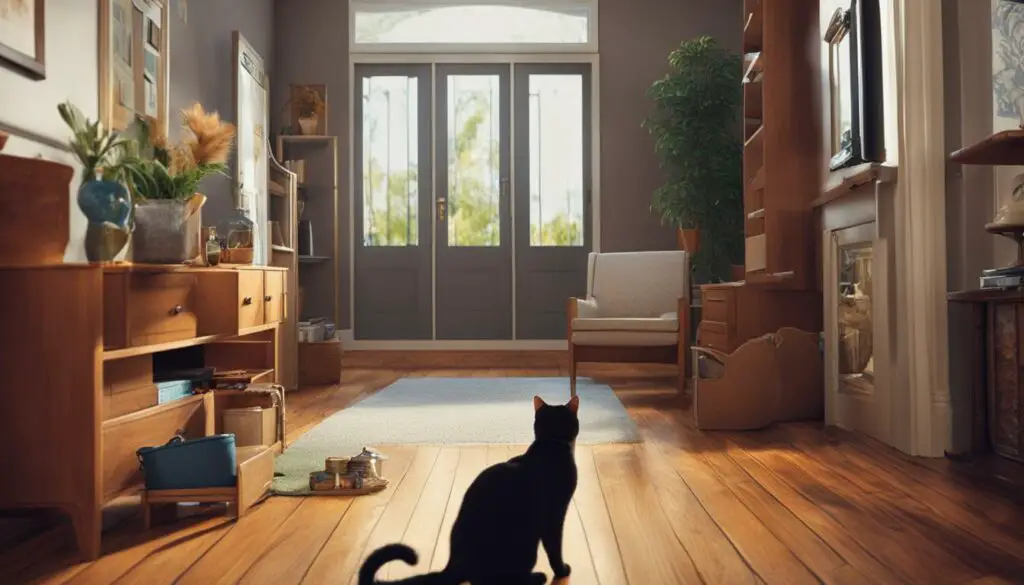
| Benefits of Indoor Training | Challenges |
|---|---|
| Prevents destructive behavior | Requires patience and consistency |
| Minimizes the risk of outdoor dangers | May take time for cats to adjust |
| Creates a safe and secure environment | Individual cats may have different learning speeds |
| Promotes good litter box habits | Requires ongoing reinforcement |
Remember, indoor training is an ongoing process that requires patience and dedication. By providing your cat with appropriate outlets for their natural behaviors, such as scratching posts and litter boxes, and using positive reinforcement to encourage desired behaviors, you can help them understand the boundaries of indoor life. With time and consistency, your cat will learn to navigate their indoor environment with confidence and contentment.
By implementing these indoor training techniques, you can create a harmonious living space for both you and your cat. Remember to be patient and consistent, and always reward your cat for their progress. With time and effort, your cat will learn to respect the boundaries of indoor life and enjoy a safe and enriching environment.
Allergies and Pregnancy: Managing Cat Ownership Indoors
For individuals with allergies or those who are pregnant, cat ownership can present unique challenges. While cats can bring immense joy and companionship to our lives, it’s important to take certain precautions to ensure the health and safety of both you and your feline friend. By making a few adjustments and creating a cat-friendly environment indoors, you can continue to enjoy the benefits of cat ownership while minimizing any potential risks.
Managing Allergies
If you have allergies, it is crucial to work with your doctor to develop a management plan that allows you to coexist comfortably with your cat. Here are some strategies to consider:
- Keep your home clean: Regularly vacuuming, dusting, and using air purifiers can help reduce allergens in your living space.
- Designate cat-free zones: Establish certain areas in your home, such as the bedroom, where your cat is not allowed to enter. This can provide you with allergy-free spaces to retreat to when needed.
- Wash your hands frequently: After interacting with your cat, be sure to wash your hands thoroughly to minimize exposure to allergens.
- Consider allergy medications or treatments: Discuss with your doctor the option of taking allergy medications or undergoing allergy treatments to help manage your symptoms.
Pregnancy and Cat Ownership
During pregnancy, it’s important to take extra precautions to ensure the well-being of both you and your unborn child. While cats themselves do not pose a direct threat to pregnancy, certain precautions can help reduce potential risks:
- Delegate litter box duties: To minimize exposure to toxoplasmosis, a parasitic infection found in cat feces, ask a family member or partner to handle litter box duties while you’re pregnant.
- Maintain good hygiene practices: Wash your hands thoroughly after any contact with your cat or their litter box to reduce the risk of infection.
- Consult your healthcare provider: If you have concerns about cat ownership during pregnancy, discuss them with your healthcare provider who can provide personalized guidance.
Remember, managing allergies and pregnancy while owning a cat is possible with the right precautions and care. By maintaining a clean and cat-friendly environment indoors, you can continue to enjoy the company of your beloved feline companion while prioritizing your health and well-being.

| Allergen Management Tips | Pregnancy Precautions |
|---|---|
| Vacuum regularly | Delegate litter box duties |
| Use air purifiers | Maintain good hygiene practices |
| Designate cat-free zones | Consult your healthcare provider |
| Wash hands frequently | |
| Consider allergy medications/treatments |
The Role of Collars in Outdoor Safety
When it comes to outdoor safety for cats, collars play a crucial role in identification and ensuring their well-being. By equipping your cat with a collar, you increase the chances of a lost cat being identified and reunited with you. Collars serve as a visible form of identification, displaying important contact information that can help others recognize your cat as a lost pet. This is especially important if your cat manages to escape through an open door or accidentally wanders off while exploring the outdoors.
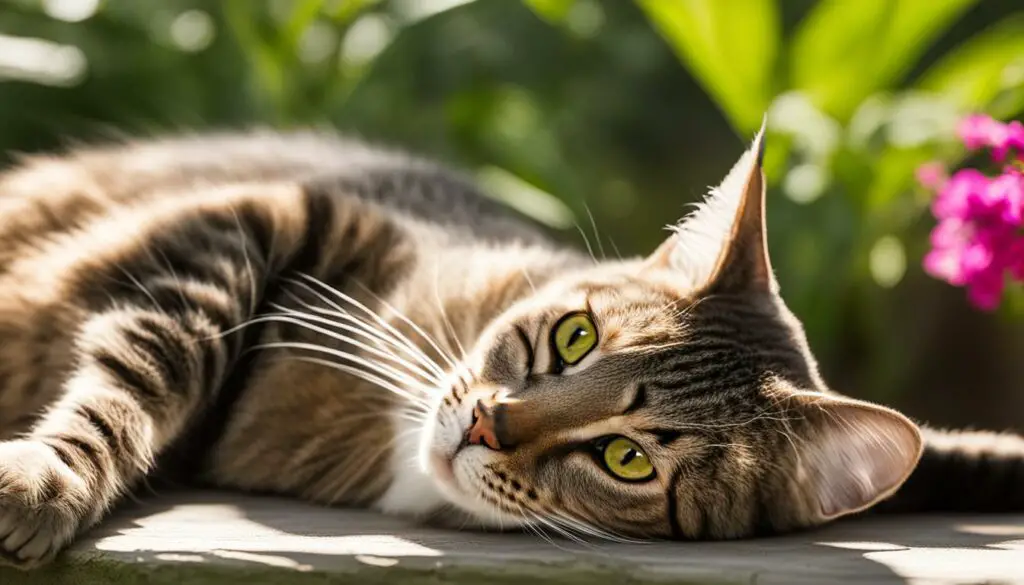
When choosing a collar for your cat, opt for one with an attached ID tag that includes your name and current contact details. This way, if your cat does become lost, anyone who finds them can easily reach out to you. It’s essential to regularly check the collar’s fit to ensure it is not too tight or too loose. A properly fitting collar should allow you to slide two fingers comfortably between the collar and your cat’s neck.
In addition to identification, collars can also provide enhanced safety features. Reflective collars, for example, can help improve your cat’s visibility during low-light conditions, reducing the risk of accidents. Personalized collars that feature breakaway mechanisms are also available, designed to release if your cat gets snagged on a branch or other objects, preventing choking or other potential injuries. These collars provide an added layer of safety while your cat enjoys supervised outdoor activities.
Strategies for Dealing with Door Dashers
If you have a cat that constantly tries to dash out the door whenever it’s opened, it’s important to take proactive measures to prevent their escape. By implementing the right strategies and distraction techniques, you can help keep your furry friend safe and secure indoors.
One effective strategy is to provide a distraction for your cat whenever someone is entering or exiting the house. Keep a jar of treats near the door and toss a few in the opposite direction to divert your cat’s attention. This will help shift their focus away from the door and onto the tasty treats, reducing the chances of them darting out.
Another useful technique is to reinforce boundaries through positive training methods. Teach your cat to associate the door with a no-go zone by using verbal cues and rewards. For example, when you approach the door, calmly say “stay” and reward your cat when they comply. Consistency and positive reinforcement will help establish the door as a boundary that your cat should not cross.
In addition to distraction and training, providing your cat with an alternative outlet for their energy and curiosity can help discourage door dashing. Set up interactive toys, scratching posts, and climbing structures near the entrance, creating a stimulating environment that will keep your cat engaged and entertained indoors.
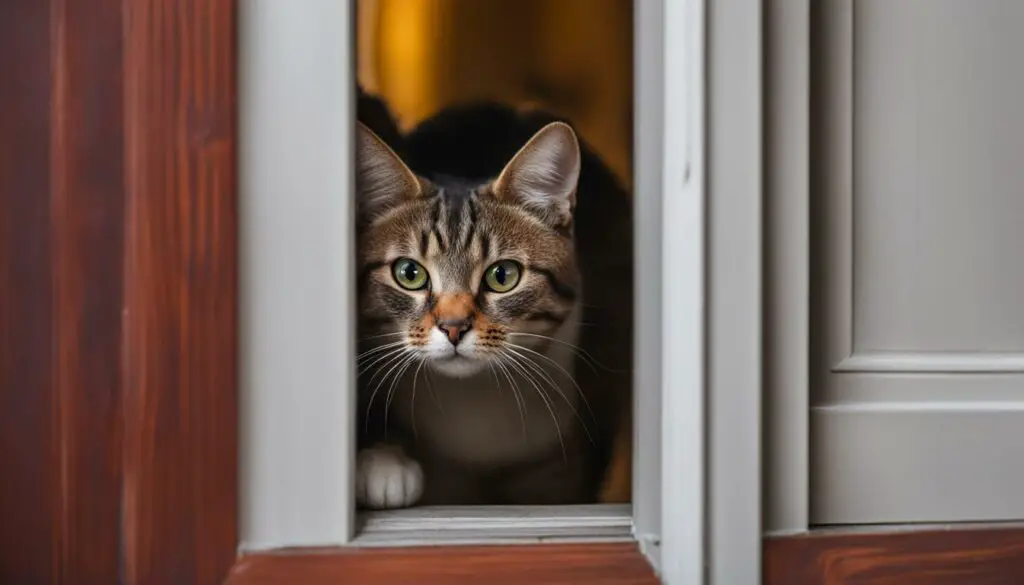
Prevention Strategies
Here are some additional prevention strategies to consider:
- Use a baby gate or a pet barrier to create a physical barrier between your cat and the door.
- Establish a routine that involves playtime and interactive sessions with your cat before opening the door.
- Keep windows closed or install secure screens to prevent your cat from escaping through them.
- Consider installing an electronic pet door that only opens for your cat, preventing other animals from entering your home.
“By implementing the right strategies and distraction techniques, you can help keep your furry friend safe and secure indoors.”
By implementing these prevention strategies and being mindful of your cat’s behavior, you can effectively deal with door dashers and reduce the risk of them escaping. Remember, the key is to create a stimulating environment, provide distractions, reinforce boundaries, and train your cat to associate the door with safety and stay indoors.
The Thrill of Escape and the Safety of Indoors
While some cats may be enticed by the thrill of escape, it is important for cat owners to prioritize the safety and well-being of their feline companions. The outdoors can pose numerous dangers, from traffic accidents to encounters with aggressive animals or exposure to toxic substances. By keeping cats indoors, we can protect them from these risks and provide a secure environment where they can thrive.
Indoor safety is crucial for cats, as it ensures their protection from various outdoor hazards. As curious creatures, cats may be lured by the sounds, scents, and sights of the outside world, but it’s our responsibility to keep them safe. By providing a stimulating and enriched environment indoors, we can fulfill their natural instincts and prevent them from seeking adventure outside.
Creating a cat-friendly home with scratching posts, climbing trees, and interactive toys can help alleviate any feelings of boredom or restlessness that may lead to a desire to escape. Furthermore, by engaging in positive training methods, we can teach our cats the boundaries of the indoor environment, reinforcing their understanding that it is a secure and fulfilling space.
Ultimately, the safety and well-being of our cats should always be our top priority. By recognizing and addressing their need for mental and physical stimulation within the confines of our homes, we can provide them with a fulfilling and secure life. Let’s embrace the joy of indoor companionship and ensure our cats live their best, safest lives.
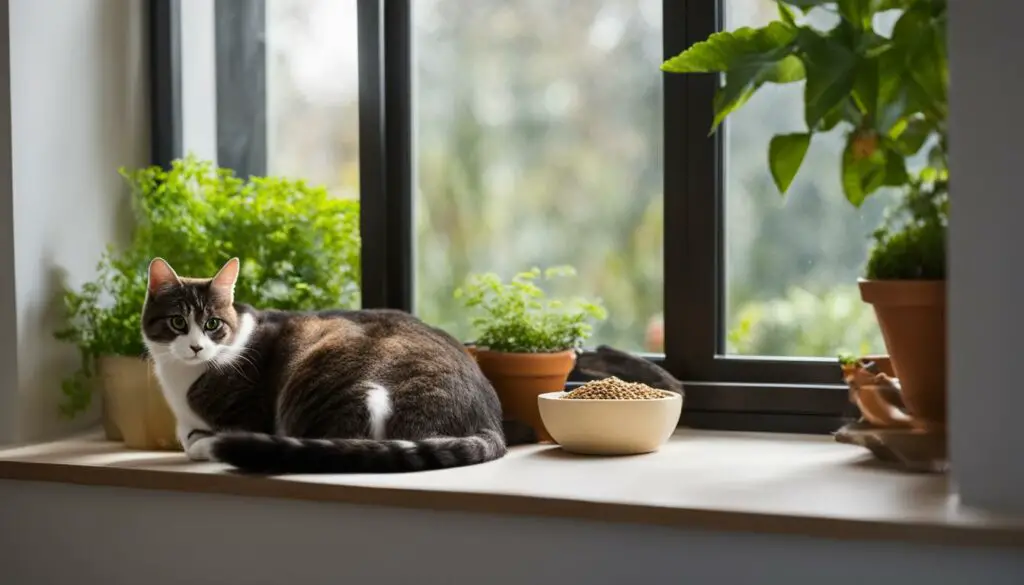
Conclusion
When it comes to keeping our cats safe, creating a secure indoor environment is crucial. By following a few simple strategies and precautions, we can prevent escapes and ensure our feline friends live happy and content lives indoors.
First and foremost, it’s important to understand the importance of an enriched environment for our cats. By providing them with toys, scratching posts, perches, and interactive games, we can prevent boredom and reduce their desire to go outside. This creates a stimulating environment that satisfies their natural instincts.
Training our cats to come when called is another valuable skill that can help in the event of an escape or emergency. Positive reinforcement, such as treats or the sound of a treat bag, can be used to teach them this reliable signal. Having a cat that responds to recall training can provide peace of mind.
Additionally, we should be cautious when opening doors to prevent our cats from darting out. Distracting them with treats or using a laser pointer can help redirect their attention. Avoiding the use of squirt bottles is recommended, as it can create a negative association with the door.
Lastly, microchipping our cats and using collars with updated contact information can provide added security in case of an escape. These measures increase the chances of a lost cat being safely reunited with their owner. By taking these steps and believing in our cat’s ability to be happy indoors, we can create a safe and secure environment for our beloved companions.
FAQ
How can I prevent my cat from escaping through an open door?
You can create a catified home with toys, scratching posts, and interactive games to reduce their desire to go outside. Additionally, you can train your cat to come when called and use distraction techniques when opening the door.
Is leash training recommended for indoor cats?
Leash training can be safe, but it depends on your cat’s temperament. Some cats may become more inclined to want to go outside when leash trained.
How can I train my cat to come when called?
You can use positive reinforcement, such as treats or the sound of a treat bag, to train your cat to come when called.
What can I do to prevent my cat from darting out the door?
You can distract your cat with treats or toys when the door is being opened and avoid using squirt bottles. Positive training methods can also help reinforce boundaries.
Are there alternate entry systems I can use to prevent cat escapes?
Yes, you can use alternate entry systems like entering through the garage or a different doorway to ensure your cat cannot escape when visitors enter or when you have your hands full.
How can I keep my cat safe during service or repair work in my home?
It’s important to confine your cat to a separate room to prevent accidental escapes and ensure their safety during the work being done.
Why is microchipping important for my cat?
Microchipping increases the chance of reuniting with your cat if they do escape. You can also consider using collars with updated contact information for added identification.
How do I transition my outdoor cat to an indoor life?
It’s important to do it gradually by introducing them to a scratching post and litter box before fully transitioning them indoors. Provide a warm and comfortable space for them to adjust to their new environment.
Can cats be happy living indoors?
Yes, many cats can live happy and fulfilling lives indoors. They may even have a preference for the comfort and security of being inside.
What are some strategies for indoor training?
You can provide your cat with appropriate outlets for their natural behaviors, such as scratching posts and litter boxes, and use positive reinforcement to encourage and reward desired behaviors.
How can I coexist with my indoor cat if I have allergies or if I’m pregnant?
It’s important to work with your doctor to manage any potential risks. There are ways to coexist with your indoor cat while minimizing any potential health concerns.
What is the role of collars in outdoor safety?
Collars can provide identification in case your cat escapes. Make sure to include updated contact information on the collar tags and consider using reflective or personalized collars.
How can I prevent my cat from darting for the door?
You can use distraction techniques such as treats or toys to prevent your cat from dashing for the door when it’s opened.
Should I let my cat go outside?
The safety of being indoors far outweighs the dangers of the outside world. Providing a secure and enriching indoor environment for your cat is the best way to keep them happy and safe.
How can I keep my cat safe with the door open?
By creating an enriching environment, training your cat, and implementing safety measures such as distractions and positive reinforcement, you can ensure that your feline friend stays protected and content inside your home.

